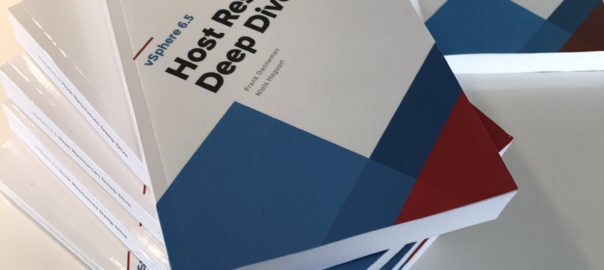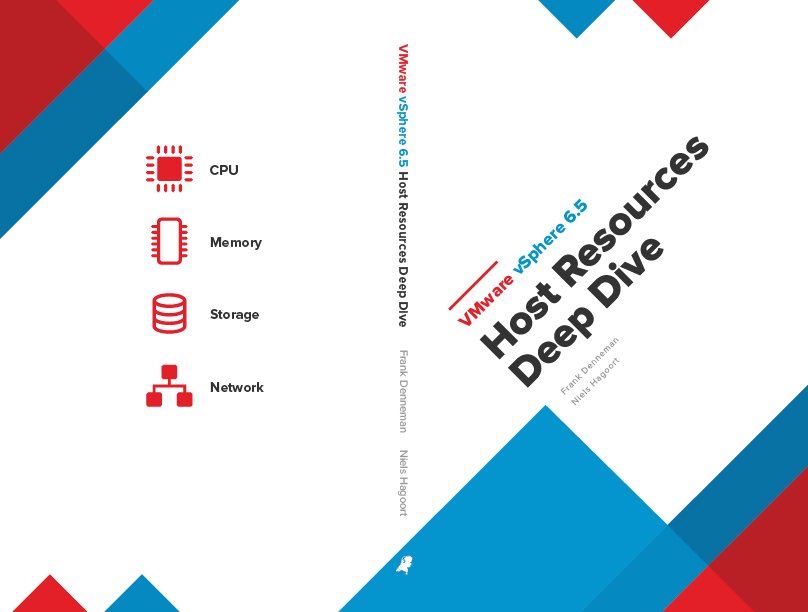It’s here!!!
I am sure many of you have been following this technical book closely, the latest publication by Frank Denneman. And now its available to order!!!! There is already a fantastic opening statement wrote by Duncan Epping today as the book is officially published.
It’s finally available! Thanks @DuncanYB for this great job introduction https://t.co/WY3quZZyeX
— HostDeepdive (@HostDeepDive) June 20, 2017
The book focuses on four key physical host component areas, and doesn’t touch VMware software features in-depth such as HA and DRS, only the host resources;
- CPU
- Memory
- Storage
- Network
As can be seen by the striking cover below.
If you haven’t already, I recommend that you give the @Hostdeepdive twitter account a follow, or at least a browse through to see some of the snippets released.
If you have read the VMware vSphere Clustering Technical Deepdive books, you already know what to expect in terms of technical level of content, however the sneak peaks show that Frank and Niels have gone even deeper than you can imagine.
See the below example,
Mapping PCIe Interfaces, important for Local Storage Controllers such as PCIe NVMe cards. #HostDeepDive pic.twitter.com/mC4qxmdizj
— HostDeepdive (@HostDeepDive) May 10, 2017
I’ve been tracking this publication closely, and wished I could have been a reviewer, but i now have my copy on order, so expect a review soon!
Where to buy?
Below are the links from everyone’s favourite retailer to purchase the paperback copy, I believe that eBook available should be after VMworld;
Amazon Book Blurb
I couldn’t really write this up better than whats on amazon;
The VMware vSphere 6.5 Host Resources Deep Dive is a guide to building consistent high-performing ESXi hosts. A book that people can’t put down. Written for administrators, architects, consultants, aspiring VCDX-es and people eager to learn more about the elements that control the behavior of CPU, memory, storage and network resources.
This book shows that we can fundamentally and materially improve the systems we’re building. We can make the currently running ones consistently faster by deeply understanding and optimizing our systems.
The reality is that specifics of the infrastructure matter. Details matter. Especially for distributed platforms which abstract resource layers, such as NSX and vSAN. Knowing your systems inside and out is the only way to be sure you’ve properly handled those details. It’s about having a passion for these details. It’s about loving the systems we build. It’s about understanding them end-to-end.
This book explains the concepts and mechanisms behind the physical resource components and the VMkernel resource schedulers, which enables you to:
Optimize your workload for current and future Non-Uniform Memory Access (NUMA) systems.
Discover how vSphere Balanced Power Management takes advantage of the CPU Turbo Boost functionality, and why High Performance does not.
How the 3-DIMMs per Channel configuration results in a 10-20% performance drop.
How TLB works and why it is bad to disable large pages in virtualized environments.
Why 3D XPoint is perfect for the vSAN caching tier.
What queues are and where they live inside the end-to-end storage data paths.
Tune VMkernel components to optimize performance for VXLAN network traffic and NFV environments.
Why Intel's Data Plane Development Kit significantly boosts packet processing performance.
Finally to round off, here is one of my recent favourite tweets from Frank, that I’ve also been sharing around work.
This is brilliant: pic.twitter.com/trPjez8lF6
— Frank Denneman (@FrankDenneman) May 16, 2017
Regards
Dean

